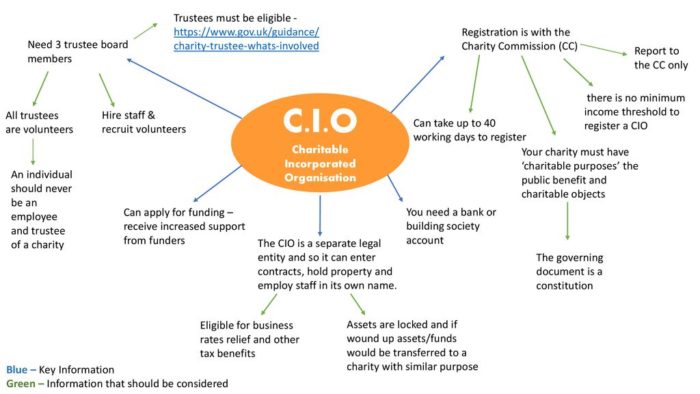
GCA became Charitable Incorporated Organisation (CIO)
The Charitable Incorporated Organisation (CIO) is a new legal form for a charity. It has been created in response to requests from the charitable sector. It is a new incorporated form of charity which is not a limited company or subject to company regulation.
CIOs have been designed specifically for charitable groups, allowing them to register just once with the Charity Commission as an incorporated form of charity which is not a company. This cuts out the need to register with and report to Companies House.
Reduced administrative burden is proposed as just one of the benefits of becoming a CIO. In addition to this, the CIO would have its own legal personaltiy and so can enter into contracts in its own right rather than in the name of individual trustees. Trustees will also have limited liability.
CIO members still have key rights in law and under the Constitution and trustees are still responsible for managing the organisation (note that trustees for CIOs will only be trustees, they will not have the dual role of Company Director).
Click HERE to download GCA Constitution of Charitable Incorporated Organisation.
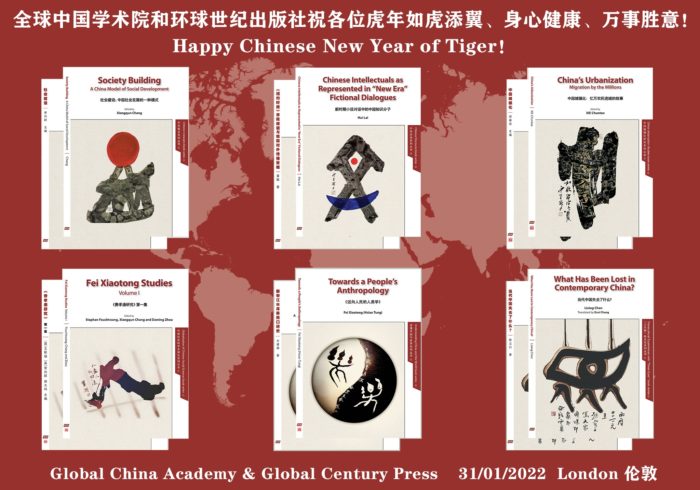
Chinese New Year Greeting (2022)
Dear colleagues and friends,
As the Year of the Tiger 2022 starts ‘mooing,’ we are delighted to extend our best wishes with this greeting card, featuring our new covers for the book series. Our publishing subsidiary, Global Century Press (GCP), is proud to offer a unique feature: a dual-language service from global, comparative, and transcultural perspectives. (Two additional book series were added in 2023; see more details).
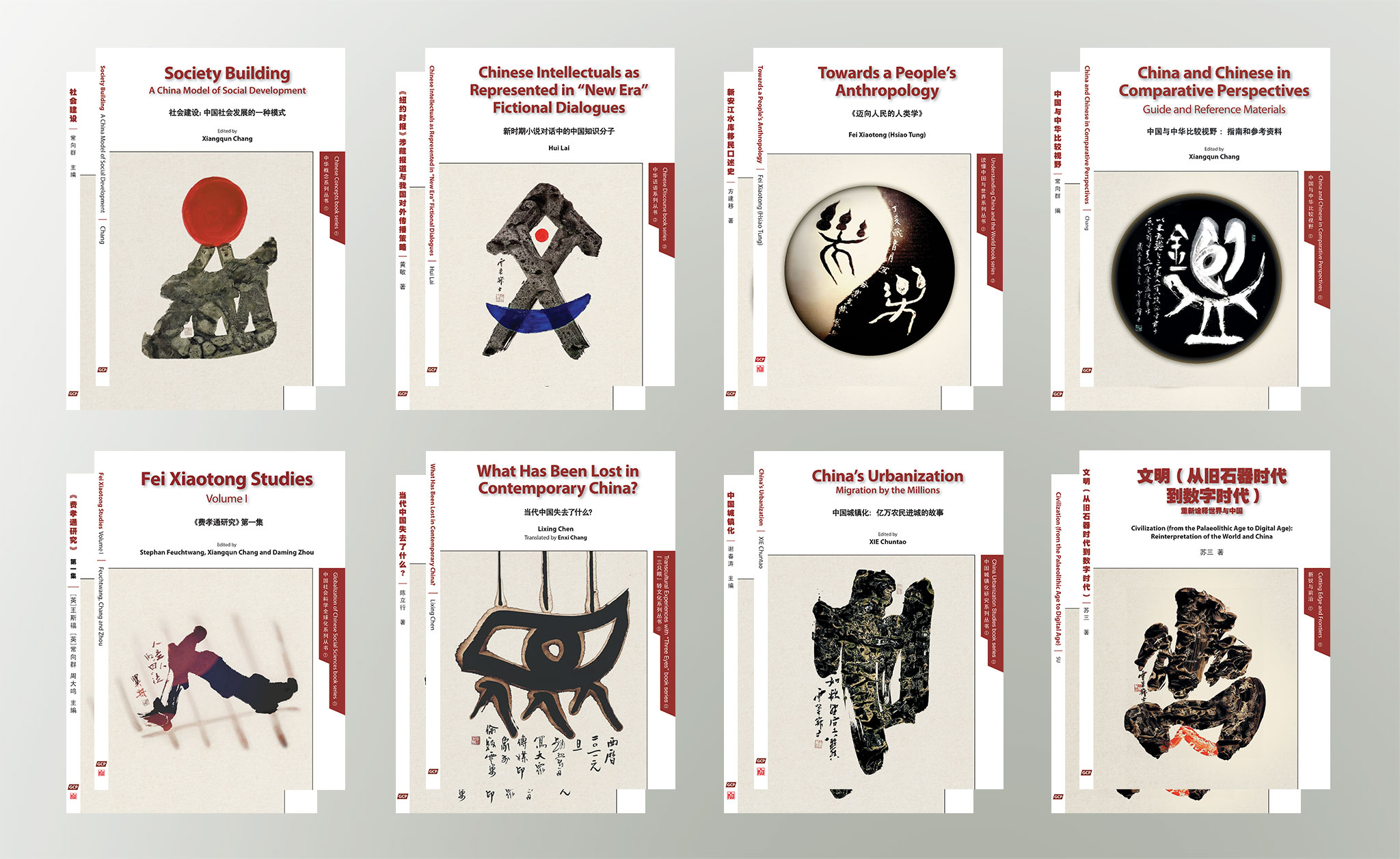
The covers of all the book series feature ‘calligraphy paintings’ (书画) selected from the transcultural works of British–Chinese calligrapher and artist Yizhou Zhao (赵翼舟), one of the finest contemporary Chinese calligraphers in the world. Each image is based on a Chinese character or phrase that to a certain extent reflects the theme of each series. For example, the Chinese character 旦 (dawn) is used for the ‘Chinese Concepts’ series; 文明 (civilization) for the ‘Chinese Discourse’ series; 乐 (happiness) for the ‘Understanding China and the World’ series; 鑑 (鉴 reflect, scrutinize, comparison) for ‘China and Chinese in Comparative Perspectives’ series; 人 (people or human beings) for the ‘Globalization of Chinese Social Sciences’ series; 众 (the masses or crowd) for the ‘Transcultural Experiences with “Three Eyes”’ series; 心 (heart) for the ‘China Urbanization Studies’ series; and 幽人 (people who are uniquely independent and creative because they live in seclusion) for the ‘Cutting Edge and Frontiers’ series. Some of the characters are directly used as the title of the image, and some of them offer more elaborate and specific meanings, e.g. ‘Man is man’s prisoner’ (《人是人的囚徒》) and ‘Mass media’ (《大众与传媒》). In the case of ‘Everybody can enjoy his own happiness’ (《各乐其乐》), the image represents yin and yang, the typical Chinese way of thinking. The artist’s rich process synthesizes the materials (including acrylic on watercolour paper, ink on rice paper, and oils) and techniques found in China and the West, and draws on the histories of both spheres to offer a dialogue between them. With deep aesthetic and philosophical underpinnings, informed by his many transcultural experiences between Chinese and Western cultures, Zhao’s work strikes a balance between tradition and innovation and illustrates the aims of both GCA and GCP.
Our charity year runs from April 1st to March 31st, different from the calendar year of January 1st to December 31st. Our annual reports for 2020-2021 and 2021-22 cover these periods. We are very pleased to share our past year’s achievements and insights through these reports. It was a year of growth, overcoming challenges, and reaching milestones, thanks to our team’s effort and commitment. We launched new initiatives, broadened our impact, and contributed significantly to our community. Looking forward, we aim to build on this with innovative strategies and continued excellence. Here’s to a prosperous Year of the Tiger, wishing everyone health, happiness, and success. We hope for your continued support, interest, and participation in our activities.
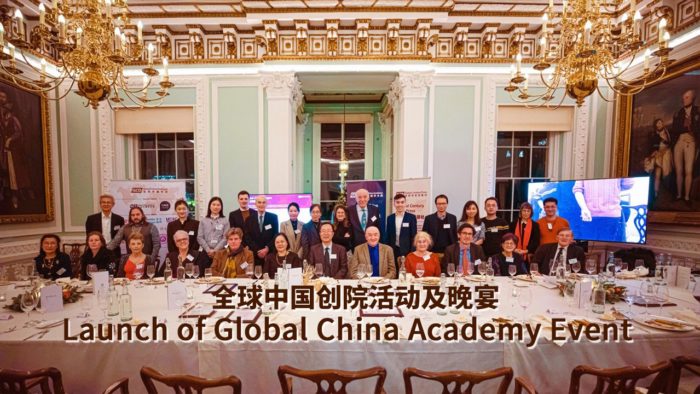
Launching Global China Academy (GCA)
There were two GCA launch sessions inserted in GCD VII: at the Opening session Professor Tony McEnery FAcSS made an announcement of founding of the Global China Academy and presented letters of thanks to retired Honorary Presidents Professor Martin Albrow FAcSS, Honorary President of Global China Academy, UK [in person] and Professor LI Qiang, Lifetime Professor and Former Dean of School of Social Sciences, Tsinghua University, China; Chinese Honorary President of Global China Academy; Chinese Chair of GCA Council and Founding Fellow. The ceremony of launching Global China Academy was held at Dinner.
Click HERE to watch both video.
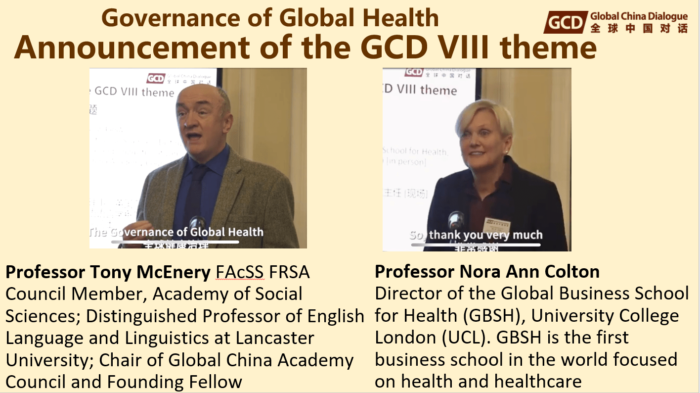
Announcement of the GCD VIII theme: Governance for global health
Professor Tony McEnery: I had conversations about how actually things like climate change are very similar in terms of the challenges that it brings two issues like global health it’s an issue where no one country can solve the issue we need to work together in order to address some of these pressing issues.
Professor Nora Ann Colton: It could not be a more timely topic as we see the challenges of global health. As we just heard, you know health governance today has been very challenged over the last two years, as we witnessed the world really struggling with containing COVID-19 alongside exposing many weaknesses in our health systems and governance as well.
Click HERE to watch video.
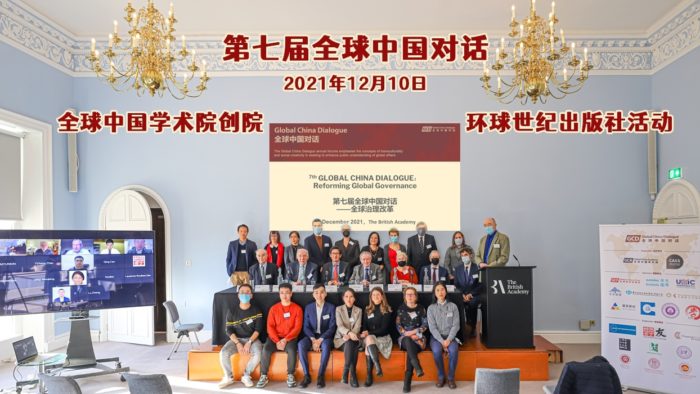
Highlights of the 7th Global China Dialogue events
We welcome you to this review of the 7th Global China Dialogue with the theme of Reforming Global Governance, and related activities. It was held at the British Academy on 10 December 10, 2021. The Dialogue consisted of four panels:
• Transformations: Society and Environment
• Digital Security and Geopolitics.
• Personal and Cultural Identities, State and Corporation
• Reforming the Institutions
The Dialogue was co-organised by the Global China Academy and the ESRC Centre for Corpus Approaches to Social Science at Lancaster University, and supported and sponsored by many universities and institutions at home and abroad.
Click HERE to watch video.
Click HERE for over 30 videos.
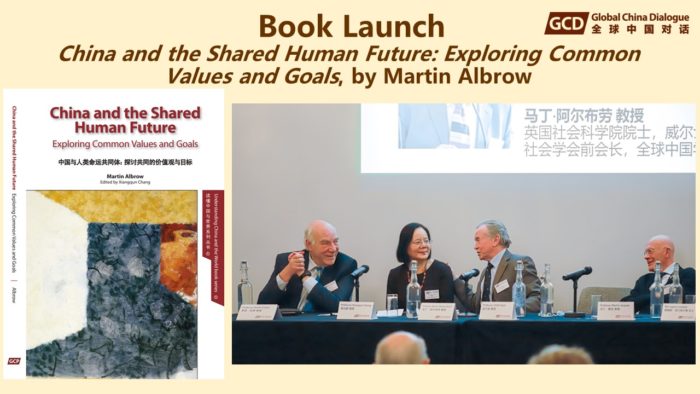
Launching a new book at GCD VII by Global Century Press
There were two GCP book launch sessions inserted in GCD VII: at the Closing the author – Professor Martin Albrow, editor – Professor Xiangqun Chang and reviewer – Professor Robin Cohen of Oxford University made short speeches. At the Reception Dr Boyi Li of the London school of Economics and Political Sciences (LSE) and Dr Yan Wu of Swansea University presented their book reviews.
Click HERE to watch videos.
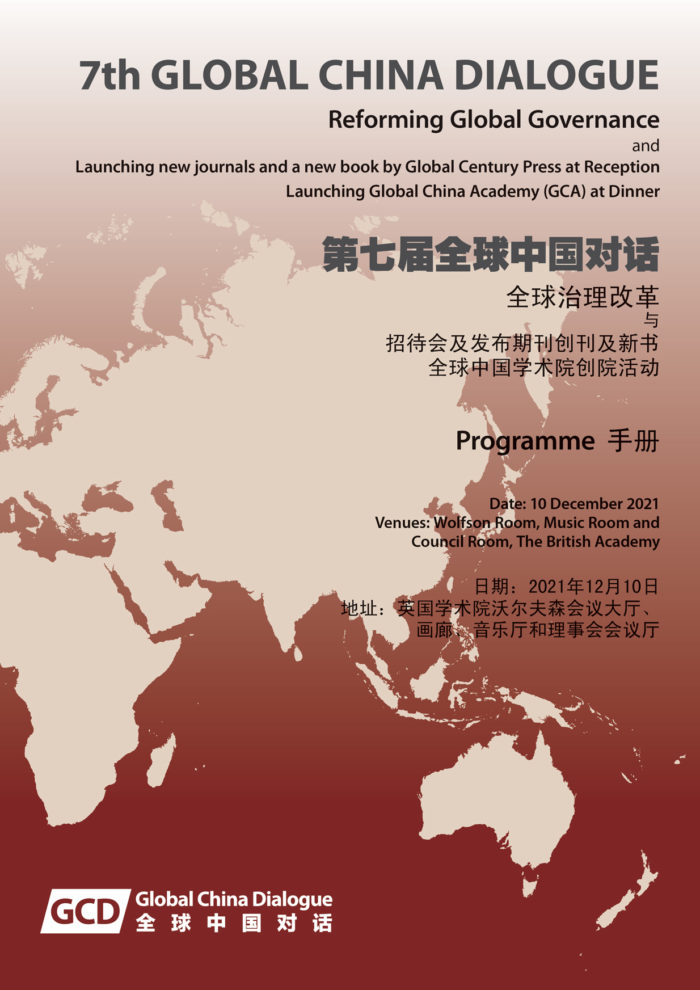
7th Global China Dialogue: Reforming Global Governance, 2021
The 7th Global China Dialogue (GCD VII), with the theme ‘Reforming Global Governance’, will be held on 10th December 2021. This is the planned culmination of a series that began in 2014 with the aim of bringing together scholars and practitioners from China and the rest of the world to exchange their insights into the
problems that challenge human existence on our planet today. Our aim is to yield proposals for the reform of global governance based on these insights.
We consider global governance in the broadest sense to cover the worldwide ordering of society to enable the peoples of the world to meet existential challenges, and to give the chance for human beings everywhere to lead fulfilling lives. China’s ‘community of a shared future for mankind’ also provided the world with a similar vision. Our panels of discussants from China and other countries will be invited to examine four areas of strategic significance for realizing these or, indeed, any visions for the governance of human society at this time of crisis.
Click HERE to download brochure.
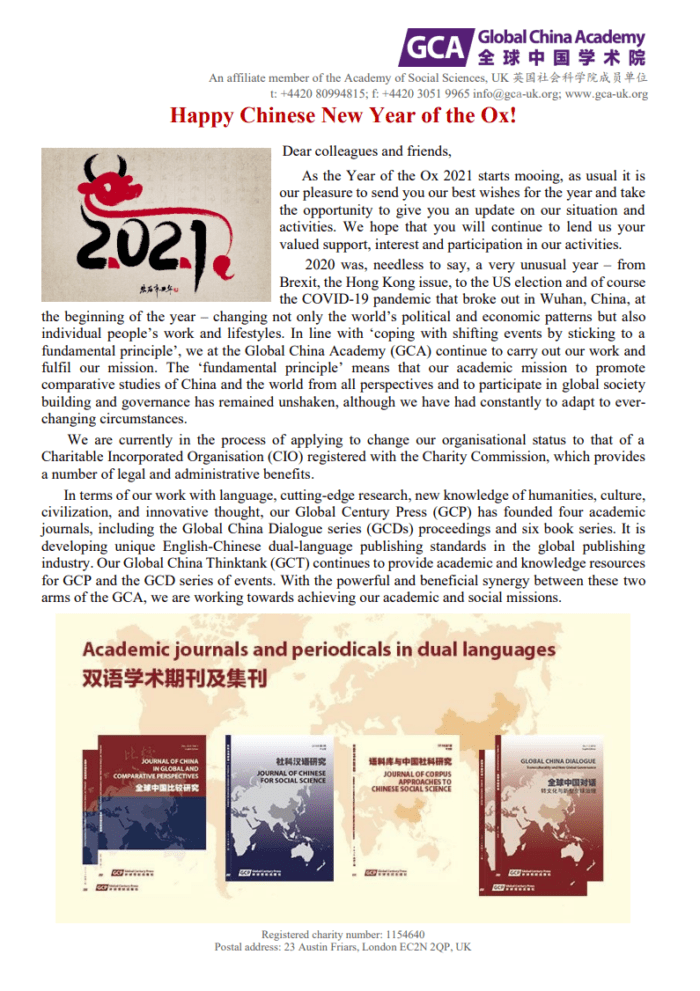
Chinese New Year Greeting Newsletter / GCA Annual Report (2020–2021)
Dear colleagues and friends,
As the Year of the Ox 2021 starts mooing, as usual it is our pleasure to send you our best wishes for the year and take the opportunity to give you an update on our situation and activities. We hope that you will continue to lend us your valued support, interest and participation in our activities.
Our 2020-2021 annual report covers our significant organizational changes, the expansion of our academic journals, and our various initiatives amidst the challenges of the COVID-19 pandemic. We discuss our ongoing commitment to promoting Chinese studies globally, our participation in international dialogues, and our efforts in building a comprehensive global network. The report reflects our resilience and adaptability in these unprecedented times.
Click HERE to download the PDF file.
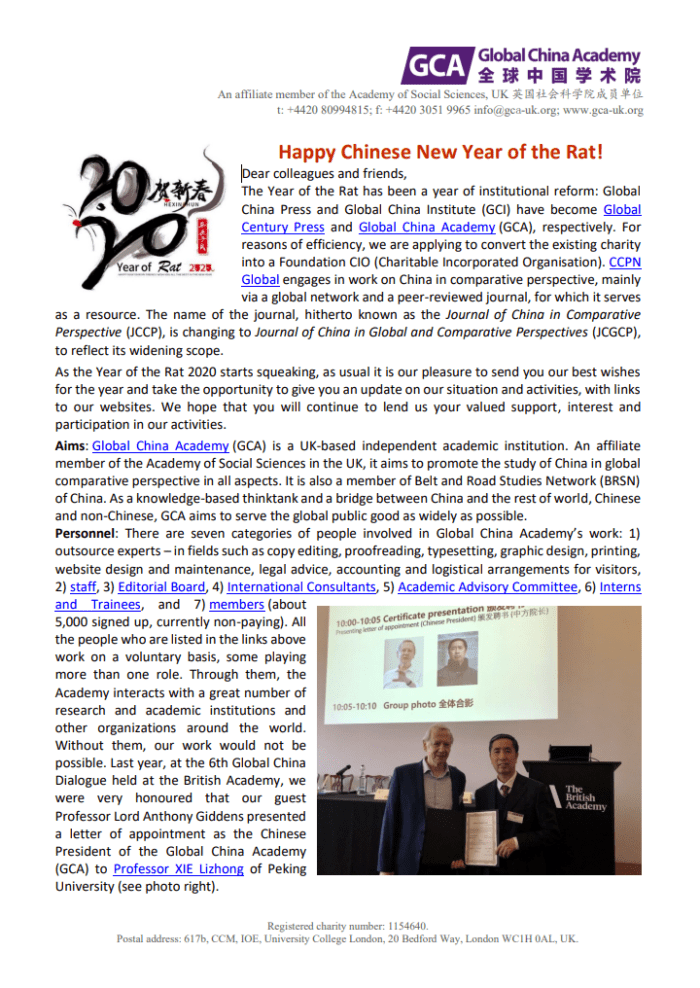
Chinese New Year Greeting Newsletter / GCA Annual Report (2019–2020)
Dear colleagues and friends,
The Year of the Rat has been a year of institutional reform: Global China Press and Global China Institute (GCI) have become Global Century Press and Global China Academy (GCA), respectively. For reasons of efficiency, we are applying to convert the existing charity into a Foundation CIO (Charitable Incorporated Organisation). CCPN Global engages in work on China in comparative perspective, mainly via a global network and a peer-reviewed journal, for which it serves as a resource. The name of the journal, hitherto known as the Journal of China in Comparative Perspective (JCCP), is changing to Journal of China in Global and Comparative Perspectives (JCGCP), to reflect its widening scope.
Our 2019-2020 annual report discusses significant organizational changes, including renaming our press and journal to better reflect our global and comparative perspective. Our report underscores our dedication to Chinese studies within a global context, highlighting our academic and social projects, publications, and our role as a knowledge-based think tank. We also detail our active participation in global dialogues and our ongoing efforts to expand and enrich our global network.
Click HERE to download the PDF file.
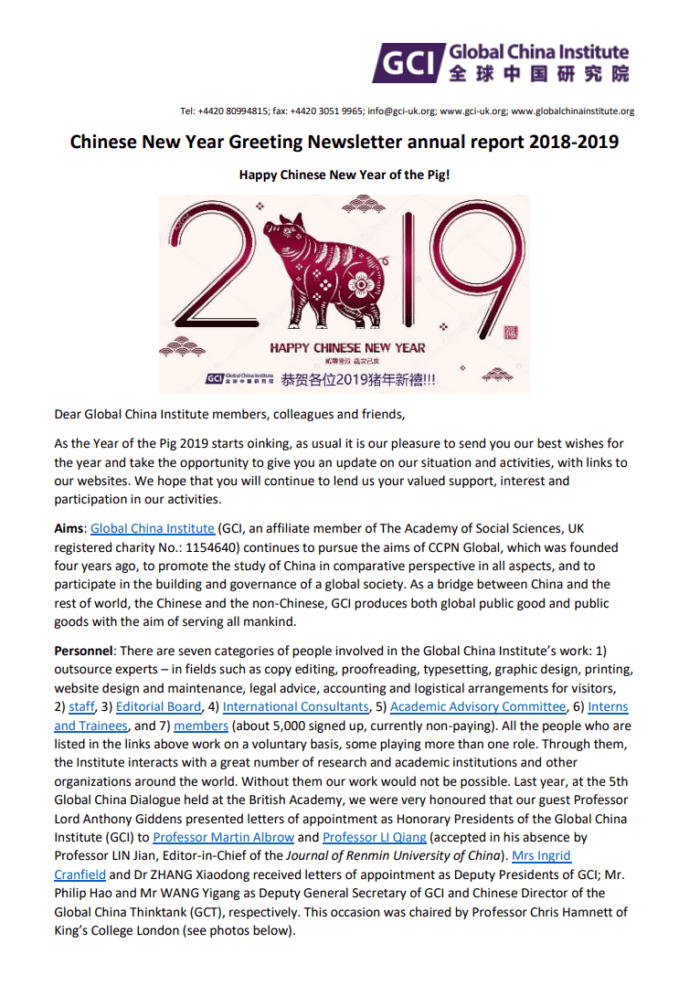
Chinese New Year Greeting Newsletter / GCI Annual Report (2018–2019)
Dear Global China Institute members, colleagues and friends,
As the Year of the Pig 2019 starts oinking, as usual it is our pleasure to send you our best wishes for the year and take the opportunity to give you an update on our situation and activities, with links to our websites. We hope that you will continue to lend us your valued support, interest and participation in our activities.
The 2018-2019 annual report shows our focus has been on enhancing global understanding of China through our internet-based initiatives, academic research, and publications. We are committed to academic excellence and societal engagement, aiming to expand our global network and strengthen knowledge exchange between China and the world. This report reflects our journey and our plans for future growth and deeper global integration.
Click HERE to download the PDF file.

